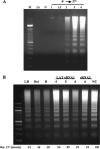Two small RNAs encoded within the first 1.5 kilobases of the herpes simplex virus type 1 latency-associated transcript can inhibit productive infection and cooperate to inhibit apoptosis
- PMID: 19587058
- PMCID: PMC2738260
- DOI: 10.1128/JVI.00871-09
Two small RNAs encoded within the first 1.5 kilobases of the herpes simplex virus type 1 latency-associated transcript can inhibit productive infection and cooperate to inhibit apoptosis
Abstract
The herpes simplex virus type 1 (HSV-1) latency-associated transcript (LAT) is abundantly expressed in latently infected trigeminal ganglionic sensory neurons. Expression of the first 1.5 kb of LAT coding sequences is sufficient for the wild-type reactivation phenotype in small animal models of infection. The ability of the first 1.5 kb of LAT coding sequences to inhibit apoptosis is important for the latency-reactivation cycle. Several studies have also concluded that LAT inhibits productive infection. To date, a functional LAT protein has not been identified, suggesting that LAT is a regulatory RNA. Two small RNAs (sRNAs) were previously identified within the first 1.5 kb of LAT coding sequences. In this study, we demonstrated that both LAT sRNAs were expressed in the trigeminal ganglia of mice latently infected with an HSV-1 strain that expresses LAT but not when mice were infected with a LAT null mutant. LAT sRNA1 and sRNA2 cooperated to inhibit cold shock-induced apoptosis in mouse neuroblastoma cells. LAT sRNA1, but not LAT sRNA2, inhibited apoptosis less efficiently than both sRNAs. When rabbit skin cells were cotransfected with plasmids that express LAT sRNA1 and HSV-1 genomic DNA, the amount of infectious virus released was reduced approximately 3 logs. Although LAT sRNA2 was less effective at inhibiting virus production, it inhibited expression of infected cell protein 4 (ICP4). Neither LAT sRNA had an obvious effect on ICP0 expression. These studies suggested that expression of two LAT sRNAs plays a role in the latency-reactivation cycle by inhibiting apoptosis and productive infection.
Figures






Similar articles
-
Identification of two small RNAs within the first 1.5-kb of the herpes simplex virus type 1-encoded latency-associated transcript.J Neurovirol. 2008 Jan;14(1):41-52. doi: 10.1080/13550280701793957. J Neurovirol. 2008. PMID: 18300074
-
Small non-coding RNAs encoded within the herpes simplex virus type 1 latency associated transcript (LAT) cooperate with the retinoic acid inducible gene I (RIG-I) to induce beta-interferon promoter activity and promote cell survival.Virus Res. 2013 Aug;175(2):101-9. doi: 10.1016/j.virusres.2013.04.005. Epub 2013 May 3. Virus Res. 2013. PMID: 23648811 Free PMC article.
-
Increased neurovirulence and reactivation of the herpes simplex virus type 1 latency-associated transcript (LAT)-negative mutant dLAT2903 with a disrupted LAT miR-H2.J Neurovirol. 2016 Feb;22(1):38-49. doi: 10.1007/s13365-015-0362-y. Epub 2015 Jun 12. J Neurovirol. 2016. PMID: 26069184 Free PMC article.
-
Bovine Herpes Virus 1 (BHV-1) and Herpes Simplex Virus Type 1 (HSV-1) Promote Survival of Latently Infected Sensory Neurons, in Part by Inhibiting Apoptosis.J Cell Death. 2013 Apr 9;6:1-16. doi: 10.4137/JCD.S10803. eCollection 2013. J Cell Death. 2013. PMID: 25278776 Free PMC article. Review.
-
Herpes simplex virus type 1 and bovine herpesvirus 1 latency.Clin Microbiol Rev. 2003 Jan;16(1):79-95. doi: 10.1128/CMR.16.1.79-95.2003. Clin Microbiol Rev. 2003. PMID: 12525426 Free PMC article. Review.
Cited by
-
LAT region factors mediating differential neuronal tropism of HSV-1 and HSV-2 do not act in trans.PLoS One. 2012;7(12):e53281. doi: 10.1371/journal.pone.0053281. Epub 2012 Dec 31. PLoS One. 2012. PMID: 23300908 Free PMC article.
-
Herpes simplex virus 1 regulates β-catenin expression in TG neurons during the latency-reactivation cycle.PLoS One. 2020 Mar 30;15(3):e0230870. doi: 10.1371/journal.pone.0230870. eCollection 2020. PLoS One. 2020. PMID: 32226020 Free PMC article.
-
Interactions between herpesvirus entry mediator (TNFRSF14) and latency-associated transcript during herpes simplex virus 1 latency.J Virol. 2014 Feb;88(4):1961-71. doi: 10.1128/JVI.02467-13. Epub 2013 Dec 4. J Virol. 2014. PMID: 24307582 Free PMC article.
-
Impaired glucocorticoid receptor function attenuates herpes simplex virus 1 production during explant-induced reactivation from latency in female mice.J Virol. 2023 Oct 31;97(10):e0130523. doi: 10.1128/jvi.01305-23. Epub 2023 Oct 12. J Virol. 2023. PMID: 37823644 Free PMC article.
-
Two microRNAs encoded within the bovine herpesvirus 1 latency-related gene promote cell survival by interacting with RIG-I and stimulating NF-κB-dependent transcription and beta interferon signaling pathways.J Virol. 2012 Feb;86(3):1670-82. doi: 10.1128/JVI.06550-11. Epub 2011 Nov 30. J Virol. 2012. PMID: 22130548 Free PMC article.
References
-
- Aiamkitsumrit, B., X. Zhang, T. M. Block, P. Norton, N. W. Fraser, and Y.-H. Su. 2007. Herpes simplex virus type 1 ICP4 deletion mutant virus d120 infection failed to induce apoptosis in nerve growth factor-differentiated PC12 cells. J. Neurovirol. 13:305-314. - PubMed
-
- Bradford, M. M. 1976. A rapid and sensitive method for the quantitation of microgram quantities of protein utilizing the principle of protein-dye binding. Anal. Biochem. 72:248-254. - PubMed
Publication types
MeSH terms
Substances
Grants and funding
LinkOut - more resources
Full Text Sources
Research Materials

